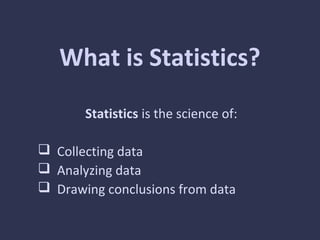
Intro to statistics formatted
- 1. What is Statistics? Statistics is the science of: Collecting data Analyzing data Drawing conclusions from data
- 2. Statistics include numerical facts and figures such as: The largest earthquake measured 9.2 on the Richter scale. Men are at least 10 times more likely than women to commit murder. One in every 8 South Africans is HIV positive. By the year 2020, there will be 15 people aged 65 and over for every new baby born.
- 3. Why should we study statistics? We want to make sense of the world. We don’t want to be lied to. We want to be able to spot trends that help us make good decisions.
- 4. 4 Main Themes: I. Exploring data (compare graphs and numbers) II. Sampling & Experimentation (collect data) III. Anticipating Patterns (Probability and Simulation) IV. Statistical Inference (Make conclusions)
- 5. Individuals are the objects described by a set of data. Variable is any characteristic of an individual. EXAMPLE: An AP Statistics class list contains information about the students enrolled. The students enrolled are the individuals, and for each individual, there are variables such as student number, gender and home phone number.
- 6. Check For Understanding You want to compare the “size of several AP statistics textbooks. Give at least three possible numerical variables that describe the “size” of a book. In what units would you measure each variable?
- 7. Possible Answers (units) Number of pages (pages) Number of words (words) Volume (cubic inches, cubic centimeters) Height and/or width (pounds, ounces) Number of chapters (chapters) Weight (pounds, ounces)
- 8. Types of variables: A categorical variable places an individual into one of several groups or categories. Examples: gender, letter grade, zip code A quantitative variable takes numerical values for which arithmetic operations such as adding and averaging make sense. Examples: scores on a test, age, GPA
- 9. Check for Understanding Data from a medical study contain values of many variables for each of the people who were the subjects of the study. Which of the following variables are categorical and which are quantitative? (a) gender (female or male) (b) Age (years) (c) Race (Asian, black, white,or other) (d) Smoker (yes or no) (e) Systolic blood pressure (millimeters of mercury) (f) Level of calcium in the blood (micrograms per milliliter)
- 10. Answers (a) categorical (b) quantitative (c) categorical (d) categorical (e) quantitative (f) quantitative
- 11. The distribution of a variable is a list (chart, picture, etc.) that tells us what values the variable takes and how often it takes these values. Most variables take on values that vary. Sometimes those values are clustered close together, and other times they are spread far apart. When we look at how those values vary, we are looking at the distribution of the variable.
- 12. Important features of a distribution: Shape Is the distribution symmetric or skewed? Outliers Are there individual observation that falls outside the overall pattern of the graph? Center Is there a typical or most common value of the variable? Is there a mode? Bimodal? Spread What is the range of possible values? How wide is the distribution?
- 13. Check For Understanding The histogram below shows the distribution of total returns for all 1528 stocks listed on the New York State Exchange in one year. (a) Describe the overall shape of the distribution of total returns. (b) What is the approximate center of this distribution? (For now, take the center to be the value with roughly half the stocks having lower returns and half having higher returns.) (c) Approximately what were the smallest and largest total returns? (This describes the spread of the distribution)
- 14. Answers (a) Roughly symmetric, though it might be viewed as SLIGHTLY skewed to the right. (b) About 15%. (39% of the stocks had a total return less than 10%, while 60% had a return less than 20%. This places the center of the distribution somewhere between 10% and 20%.) (c) The smallest return was between -70% and -60%, while the largest was between 100% and 110%.
- 15. When analyzing data, ask the following: Who are the individuals being described? What are the variables? Why were the data gathered? When, where, how, and by whom were the data produced?
- 16. Check For Understanding In October 2005 Discover published an article on the colonies of ants. They reported some basic information about many species of ants and the results of some discoveries found by myrmecologist Walter Tschinkel of the University of Florida. Information included the scientific name of the ant species, the geographic location, the depth of the nest (in feet), the number of chambers in the nest, and the number of ants in the colony. The article documented how new ant colonies begin, the ant-nest design, and how nests differ in shape, number, size of chambers, and how they are connected, depending on the species. It reported that nest designs include vertical, horizontal, or inclined tunnels for movement and transport of food and ants. Describe the W's, if the information is given. If the information is not given, state that it is not specified. Who: What: When: Where: How: Why:
- 17. Answers Who: Colonies of ants. "Many species of ants," but no indication of exactly how many. What: scientific name, geographic location, average nest depth, average number of chambers, average colony size, how new ant colonies begin, the ant-nest design, and how nests differ in architecture. When: October 2005 Where: not specified How: The results of some discoveries found by myrmecologist Walter Tschinkel of the University of Florida Why: Information of interest to readers of the magazine